| View previous topic :: View next topic |
| Author |
Message |
Duncan Miller

Joined: 25 Apr 2009
Posts: 138
Location: South Africa



|
 Posted: Sep 08, 2011 04:46 Post subject: Re: Mineral specimens with inclusions Posted: Sep 08, 2011 04:46 Post subject: Re: Mineral specimens with inclusions |
|
|
Maxilos
The 'rutile' in your specimen look a lot like the cacoxenite tufts in this amethyst. Admittedly it is tricky to identify such inclusions visually, but according to Webster's "Gems" cacoxenite inclusions are common in amethyst. (OK, I will stop posting cut stones now.)
Duncan
| Description: |
Quartz with cacoxenite inclusions
Brazil
12 mm square, 10.89 ct |
|
| Viewed: |
47347 Time(s) |
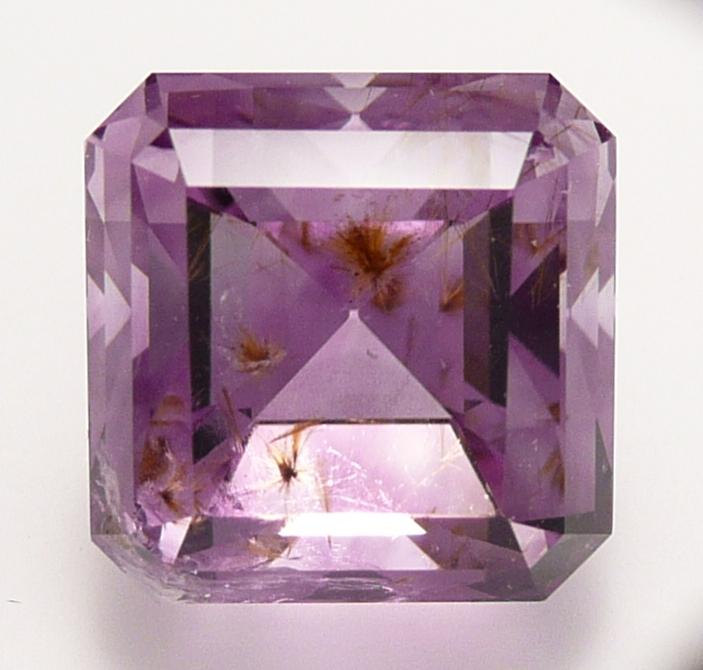
|
|
|
| Back to top |
|
 |
John S. White
Site Admin

Joined: 04 Sep 2006
Posts: 1298
Location: Stewartstown, Pennsylvania, USA



|
 Posted: Sep 08, 2011 05:20 Post subject: Re: Mineral specimens with inclusions Posted: Sep 08, 2011 05:20 Post subject: Re: Mineral specimens with inclusions |
|
|
Oh please, not "cacoxenite" again! What does one have to do to permanently bury this false identification. The inclusions in amethyst from Brazil are NOT cacoxenite, they are goethite, as has been stated more than once on FMF. In fact, on this very thread, just days ago, I posted a photo of amethyst with goethite inclusions. Here it is again. Duncan, did you not notice that? There are no phosphates associated with the geodes that contain the amethyst from Rio Grande do Sul. Never, in my experience, has any misidentification been perpetuated to the degree that this one has. Goethite, please, and it is quite clear that the piece Maxilos has is goethite.
Finally,just because our fearless leader Jordi does not like polished pieces, please continue to post photos of them when appropriate. I fully intend to.
| Description: |
|
| Viewed: |
47334 Time(s) |
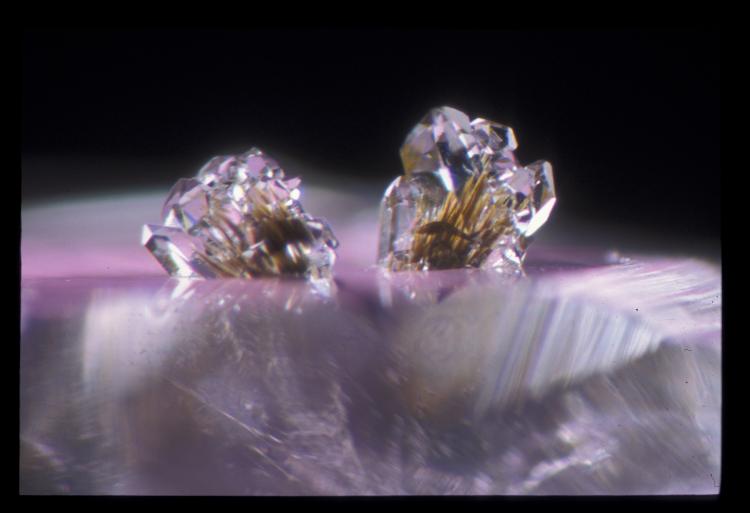
|
_________________
John S. White
aka Rondinaire |
|
| Back to top |
|
 |
Duncan Miller

Joined: 25 Apr 2009
Posts: 138
Location: South Africa



|
 Posted: Sep 08, 2011 05:51 Post subject: Re: Mineral specimens with inclusions Posted: Sep 08, 2011 05:51 Post subject: Re: Mineral specimens with inclusions |
|
|
Hi John
I am glad to have been corrected, thank you. Yes, I did notice your photo of the goethite, saw its similarity to the tufts in my amethyst, and tried to cover myself by saying that visual ID is dicey! (The edition of Webster's Gems I referred to was the 5th edition, reprinted 2003, edited by Peter Read.) As to what one has to do to bury such false identifications permanently, perhaps there is a need for a cumulative 'recurrent false IDs' thread with illustrated examples.
Duncan
|
|
| Back to top |
|
 |
John S. White
Site Admin

Joined: 04 Sep 2006
Posts: 1298
Location: Stewartstown, Pennsylvania, USA



|
 Posted: Sep 08, 2011 08:13 Post subject: Re: Mineral specimens with inclusions Posted: Sep 08, 2011 08:13 Post subject: Re: Mineral specimens with inclusions |
|
|
Hi Duncan:
Thank you for your response. It is interesting that the 2003 edition of Webster's Gems would make that mistake. I do not have that book, but my copy of Webster's Gemmologists' Compendium (6th edition 1979) carries the statement: "the name (cacoxenite) is often misleadingly applied to quartz (often amethyst) containing yellowish tufts of goethite."
It is amazing that Peter Read would change what was correct to something incorrect.
_________________
John S. White
aka Rondinaire |
|
| Back to top |
|
 |
Antonio Alcaide
Site Admin

Joined: 23 Aug 2009
Posts: 314
Location: Spain



|
 Posted: Sep 08, 2011 19:36 Post subject: Re: Mineral specimens with inclusions Posted: Sep 08, 2011 19:36 Post subject: Re: Mineral specimens with inclusions |
|
|
Very nice drawings, Elise. Please, keep on posting them.
Regards
_________________
Life is the shortest crystal |
|
| Back to top |
|
 |
Jordi Fabre
Overall coordinator of the Forum

Joined: 07 Aug 2006
Posts: 5027
Location: Barcelona



|
 Posted: Sep 13, 2011 02:36 Post subject: Re: Mineral specimens with inclusions Posted: Sep 13, 2011 02:36 Post subject: Re: Mineral specimens with inclusions |
|
|
| xenolithos wrote: |
...As to what one has to do to bury such false identifications permanently, perhaps there is a need for a cumulative 'recurrent false IDs' thread with illustrated examples.
|
Is a sub-forum in FMF, "Incorrect classification and fakes" , where the false identifications can be discussed. Antonio created there a new thread: "Goethite -not cacoxenite- inclusions in amethyst from Brazil" ( https://www.mineral-forum.com/message-board/viewtopic.php?t=1939 ) where this topic of the Goethites-not Cacoxenites has been copied.
|
|
| Back to top |
|
 |
Elise

Joined: 22 Dec 2009
Posts: 243
Location: New York State



|
 Posted: Sep 13, 2011 18:20 Post subject: Re: Mineral specimens with inclusions Posted: Sep 13, 2011 18:20 Post subject: Re: Mineral specimens with inclusions |
|
|
| xenolithos wrote: | | visual ID is dicey! (The edition of Webster's Gems I referred to was the 5th edition, reprinted 2003, edited by Peter Read.) |
Duncan, it is wise that you point out that we shouldn't be making "sight IDs" from photographs, only perhaps opinions. My own thought is that even with the specimen in one hand and a book in the other, the process is fraught with pitfalls. The goethite inclusions in quartz come in so many different forms, as can be seen in John Koivula's Photoatlas, but I am not sure I would have recognized it conclusively in any of the photos above. I wonder what caused an author to make the initial mistaken ID of cacoxenite despite its rarity and incompatible chemistry with quartz or its growth environment. Or perhaps it was based on morphology alone.
It is an interesting aside that in Frondel (7th) the presence of goethite pointed to the role of iron in the purple color; it mostly forms in the colorless areas - I assume this where the iron is taken up by the growing goethite; a kind of chromophore canniblization to use a Koivula expression (correct me if that is a wrong assumption). It is also a factor in the formation of Brazil law twinning, though at almost nano-crystal scale.
Also, I am not sure how to distinguish goethite from hematite, other than in a case such as the image below where the goethite has transformed to hematite, shown as black tips as its growth environment dehydrated (Koivula). You can see some of this color zoning in the crystal cluster below, along with the numerous tufts. Jaroslav Hyrsl wrote that "is difficult to differentiate goethite, hematite and rutile when completely enclosed in quartz." so I should not feel too badly.
| John S. White wrote: | | It is interesting that the 2003 edition of Webster's Gems would make that mistake. I do not have that book, but my copy of Webster's Gemmologists' Compendium (6th edition 1979) carries the statement: "the name (cacoxenite) is often misleadingly applied to quartz (often amethyst) containing yellowish tufts of goethite."It is amazing that Peter Read would change what was correct to something incorrect. |
John, the editions before and after carry the same mis-identification; all three by noted mineralogist/gemmologist editors; I don't have the 3rd edition by the original author to know whether it had been changed. It was also so by mineralogist and famed inclusionist Dr. Gübelin, though corrected by John Koivula in all editions of their co-authored Photoatlas series (I can point to other types of similar errors in Sinkankas, Hurlbut and numerous journals as well). Was this started in the gemological community or in the mineralogy world? I am feeling my knees getting weak and a faint rubbery feeling develop in my other limbs.
Carry on!
Elise
| Description: |
| Golden goethite transitioning to black hematite; an inclusion in the amethyst quartz cluster shown below; unknown locality, approx. 3.5 mm (photo: E. Skalwold). |
|
| Viewed: |
47036 Time(s) |
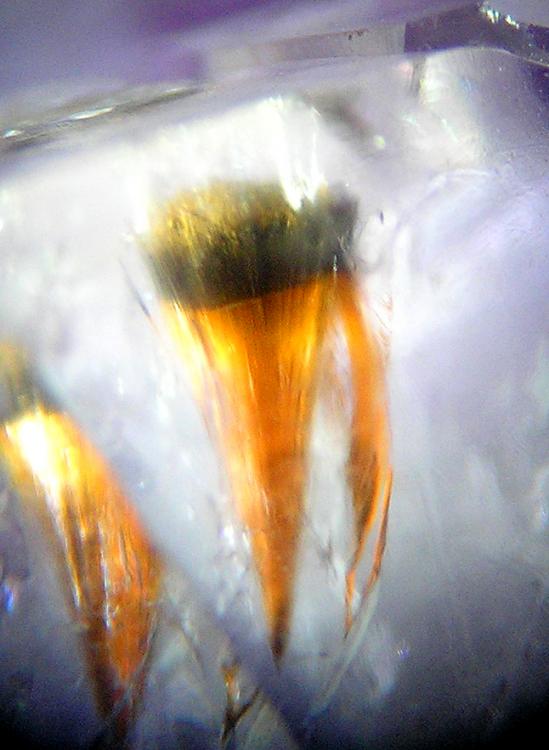
|
| Description: |
| Amethyst quartz, unknown locality, approx. 4 inches across (photo: E. Skalwold). |
|
| Viewed: |
47108 Time(s) |
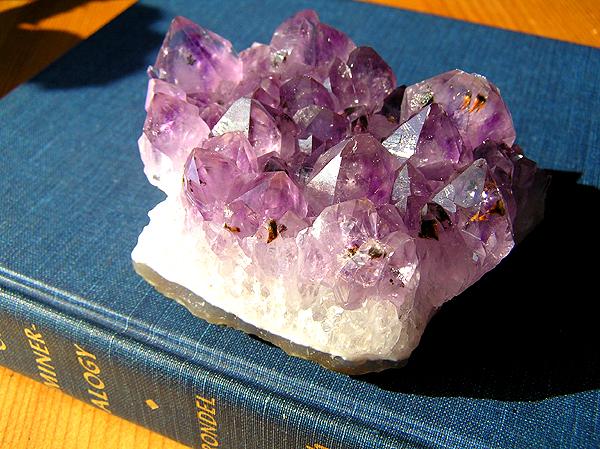
|
_________________
Elise Skalwold |
|
| Back to top |
|
 |
dtkasper
Joined: 27 Dec 2010
Posts: 13
Location: Lancaster


|
|
| Back to top |
|
 |
dtkasper
Joined: 27 Dec 2010
Posts: 13
Location: Lancaster


|
 Posted: Sep 13, 2011 22:07 Post subject: Re: Mineral specimens with inclusions Posted: Sep 13, 2011 22:07 Post subject: Re: Mineral specimens with inclusions |
|
|
Goethite/cacoxenite.
Melody wrote a recent book on healing stones. She is a prolific writer of her analysis of all the powers of stones of the world. She is out of England. She labelled cacoxenite as having extraordinary powers unlike any other inclusion. The rest is history. Value of the stuff went through the roof. For the superstitious, you lose. This is why it continues to be perpetuated.
_________________
I collect, therefore I am. |
|
| Back to top |
|
 |
dtkasper
Joined: 27 Dec 2010
Posts: 13
Location: Lancaster


|
 Posted: Sep 13, 2011 22:09 Post subject: Re: Mineral specimens with inclusions Posted: Sep 13, 2011 22:09 Post subject: Re: Mineral specimens with inclusions |
|
|
I have never seen goethite dendrites in an agate. These appear to be one of the manganese dendritic minerals.
_________________
I collect, therefore I am. |
|
| Back to top |
|
 |
dtkasper
Joined: 27 Dec 2010
Posts: 13
Location: Lancaster


|
 Posted: Sep 13, 2011 22:20 Post subject: Re: Mineral specimens with inclusions Posted: Sep 13, 2011 22:20 Post subject: Re: Mineral specimens with inclusions |
|
|
Does Koivula also study inclusions in agates?
_________________
I collect, therefore I am. |
|
| Back to top |
|
 |
Duncan Miller

Joined: 25 Apr 2009
Posts: 138
Location: South Africa



|
 Posted: Sep 14, 2011 01:10 Post subject: Re: Mineral specimens with inclusions Posted: Sep 14, 2011 01:10 Post subject: Re: Mineral specimens with inclusions |
|
|
| Elise wrote: | | I am not sure how to distinguish goethite from hematite |
To add to the confusion, haematite in quartz often gets described as lepidocrocite, both being red in thin flakes.
We all need a Raman spectroscope in the garage!
Duncan
|
|
| Back to top |
|
 |
Debbie Woolf
Joined: 09 Feb 2009
Posts: 168
Location: Kent



|
 Posted: Sep 14, 2011 10:12 Post subject: Re: Mineral specimens with inclusions Posted: Sep 14, 2011 10:12 Post subject: Re: Mineral specimens with inclusions |
|
|
| xenolithos wrote: |
To add to the confusion, haematite in quartz often gets described as lepidocrocite, both being red in thin flakes.
Duncan |
To follow what Duncan says this is the often misrepresented Brandberg Quartz & Lepidocrocite
| Description: |
Quartz & Hematite inclusion
Goboboseb Mountains, Namibia
4.5cm x 1cm |
|
| Viewed: |
46480 Time(s) |
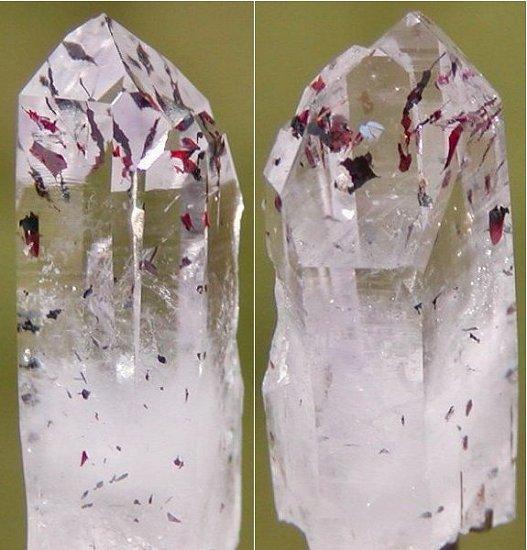
|
|
|
| Back to top |
|
 |
Debbie Woolf
Joined: 09 Feb 2009
Posts: 168
Location: Kent



|
 Posted: Sep 14, 2011 10:18 Post subject: Re: Mineral specimens with inclusions Posted: Sep 14, 2011 10:18 Post subject: Re: Mineral specimens with inclusions |
|
|
Epidote in Quartz to 6mm.
| Description: |
Quartz, Hematite & Epidote inclusion
Goboboseb Mountains, Namibia |
|
| Viewed: |
46449 Time(s) |
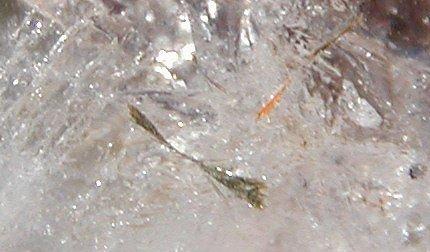
|
|
|
| Back to top |
|
 |
Elise

Joined: 22 Dec 2009
Posts: 243
Location: New York State



|
 Posted: Sep 15, 2011 21:28 Post subject: Re: Mineral specimens with inclusions Posted: Sep 15, 2011 21:28 Post subject: Re: Mineral specimens with inclusions |
|
|
| dtkasper wrote: | | Does Koivula also study inclusions in agates? |
In the book Photoatlas of Inclusions in Gemstones, Volume 2, John Koivula devotes 25 pages to the subject of chalcedony with somewhere around 80 spectacular photos of the inclusions which can make agates so spectacular - whether viewed under the microscope or just in the hand. For those that have that volume, my favorite image is on page 361, top right where a bouquet of single quartz crystals is shown in a halo of light blue cryptocrystalline quartz. I think John has a special love of quartz and its inclusions; both chalcedony and single crystal varieties which are well represented in Vol. 1 & 2 and in his many other articles in numerous periodicals.
In the thread we had going about Brazil law twinning, I had posted a related type of occurrence, more spectacular when seen between crossed polars under the microscope https://www.mineral-forum.com/message-board/viewtopic.php?p=16714 A close-up of one its single quartz crystal inclusions is shown below (it has unknown needle-like inclusions as well). The image below that is a neat slice of sectored quartz, encased in carnelian with needles extending from the carnelian rim into the single quartz.
In both cases the c-axis of the original whole quartz crystal is in the middle, perpendicular to the image. It would have been neat to see the original crystal before being sliced. The portrait in the Photoatlas mentioned above gives me an idea at least of how it might have looked from the side.
Best wishes,
Elise
| Description: |
| Cross-section of single quartz crystal surrounded in chalcedony host. The inclusion is approximately 7mm wide and has fine needle-like inclusions itself. |
|
| Viewed: |
46435 Time(s) |
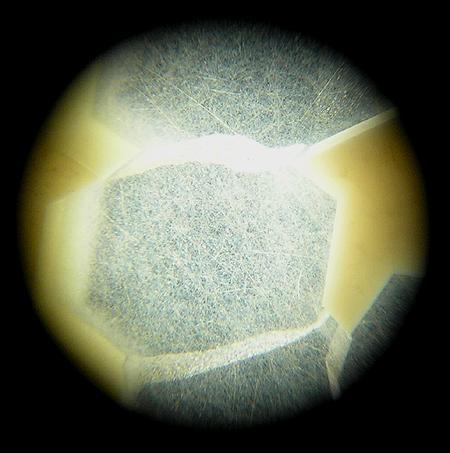
|
| Description: |
| Sectored quartz surrounded by cryptocrystalline quartz (carnelian) with needles extending into the interior single crystal quartz - Luna moth wing for scale (Photo: E. Skalwold). |
|
| Viewed: |
46416 Time(s) |
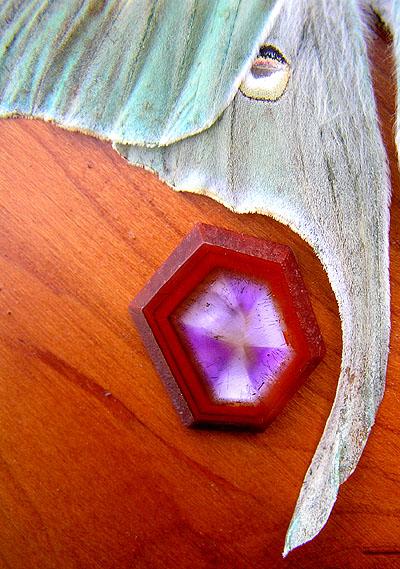
|
_________________
Elise Skalwold |
|
| Back to top |
|
 |
|





